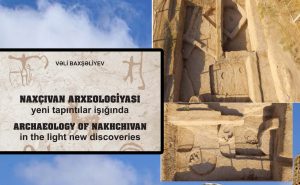Archaeology of Nachchivvan in the light new discoveries

INTRODUCTION
The Autonomous Republic of Nakhchevan, a province of Azerbaijan with a specific political status, is located in the middle Araxes basin along a major East-West axis, formerly known as the northern “Silk Road”. Of particular im-portance during the Middle Ages, this road used to link India to Europe, via Tabriz, Erzurum and then Constantinople through the great Anatolian highway. Nakhchevan is thus located in one of the most strategic points of the South Caucasus, a region which played a major role not only in the history of Trans-caucasia, but also of the Near and Middle East, Anatolia and the Mediterranean world. The Araxes valley has the shape of a wide corridor running from West to East, between the high peaks of the Lesser Caucasus to the North, the Zagros and the Oriental Taurus to the South. Mount Agri, whose summit culminates at 5137 m, is located to the south of this corridor. During the Lower Paleotithic, the Araxes valley probably had a central function in the migrations of hominids from Africa into Europe, as suggested by the discovery of early hominid skeletal remains at Dmanisi in Georgia. Together with its strategic location, Nakhchevan is characterized by its wealth in natural resources, among which copper and salt, which were of special importance to preindustrial economies. The history of archaeology in Nakhchevan dates back to the 19th century. In the 1870’s, stone hammers were found by chance on the slopes of Duzdagi, a salt mine that is located a few kilometers from the city of Nakhchevan; these hammers were attributed by K.A.Nikitin and I.S. Polyakov to the extraction of salt. Yet, the period during which these objects were used has remained unknown for a long time. A few years later, the chance finds of painted vessels in the cemetery of Kizilburun (formerly known as Kizilvank) in 1895 also raised enormous interest; in 1896, this necropolis was excavated by N.V.Fyodorov with the authorisation of the Imperial Archeological Committee. The finds, which consisted mostly of painted vessels, bronze daggers and body ornaments, were sent to Moscow. Systematic excavations however, as elsewhere throughout the world, only started in the course of the XX century in the Soviet period. Important research was conducted by I.I. Messaninov, A.A. Miller, A.K. Alekperov, O.H. Abibullayev, V. H. Aliyev, K. M. Aslanov, S. M. Kaskay, B. I. Ibrahimov, K. H. Agayev, V. B. Bahsaliyev, A. K. Seyidov, S. H. Asurov, E. K. Jaferov, N. E. Museyibli, E. K. Bedelov, C. Marro, L. Ristvet, H.Gopnik and others covering the Paleolithic period down to the Iron Age. Curiously enough, field research was in fact mostly focused on the Bronze Age, so that many gaps remain in the knowledge of other periods. In an attempt to assess Azerbaijan’s archaeological heritage, the former president of the Republic of Azerbaijan, Haydar Aliyev, together with the president of the Nakhchevan Autonomous Republic, Vasif Talibov, instigated the inventory of the archaeological sites of Nakhchevan. This work led to the recent discovery of many mounds and cemeteries. Concomittantly, new excavations were launched, some of which started in collaboration with foreign teams, such as the projects initiated at Ovchular Tepe and Makhta’°. Ten years after the short synthesis published in English by V. Bahsaliyev, which was the first to introduce the western academic world to the achievements of archeological research in Nakhchevan, we would like now to take advantage of the numerous discoveries that have been made in this region over the last few years to update the state of the art: this book is thus an endeavour to present ongoing research as well as to open new scientific perspectives.
Veli Bakhshaliyev







